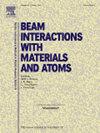Effects of linear energy transfer on thermoluminescence properties of Eu-doped CaF2 ceramics
IF 1.4
3区 物理与天体物理
Q3 INSTRUMENTS & INSTRUMENTATION
Nuclear Instruments & Methods in Physics Research Section B-beam Interactions With Materials and Atoms
Pub Date : 2025-07-01
DOI:10.1016/j.nimb.2025.165785
引用次数: 0
Abstract
Linear energy transfer (LET) effects on thermoluminescence (TL) properties of Eu:CaF2 ceramics were evaluated. TL glow curves were measured after irradiations with ion beams (160-MeV H, 150-MeV/n He, or 135-MeV/n C). They showed two glow peaks at 350 and 400 K. The intensity decreased with increase of Eu concentrations and LET. In addition, the decrease in the TL intensity with LET was suppressed at high Eu concentration. These results were explained in terms of the competition between the trapping of electrons and holes, which contribute to the TL, and the quenching (recombination) of electron-hole pairs owing to excited states interaction.
线性能量传递对铕掺杂CaF2陶瓷热释光性能的影响
研究了线性能量传递(LET)对Eu:CaF2陶瓷热释光(TL)性能的影响。在离子束(160-MeV H, 150-MeV/n He或135-MeV/n C)照射后,测量了TL发光曲线。它们在350和400 K处显示出两个发光峰。强度随Eu浓度和LET的增加而降低。此外,高Eu浓度抑制了LET对TL强度的降低。这些结果被解释为电子和空穴的捕获之间的竞争,这有助于TL,以及由于激发态相互作用导致的电子-空穴对的猝灭(复合)。
本文章由计算机程序翻译,如有差异,请以英文原文为准。
求助全文
约1分钟内获得全文
求助全文
来源期刊
CiteScore
2.80
自引率
7.70%
发文量
231
审稿时长
1.9 months
期刊介绍:
Section B of Nuclear Instruments and Methods in Physics Research covers all aspects of the interaction of energetic beams with atoms, molecules and aggregate forms of matter. This includes ion beam analysis and ion beam modification of materials as well as basic data of importance for these studies. Topics of general interest include: atomic collisions in solids, particle channelling, all aspects of collision cascades, the modification of materials by energetic beams, ion implantation, irradiation - induced changes in materials, the physics and chemistry of beam interactions and the analysis of materials by all forms of energetic radiation. Modification by ion, laser and electron beams for the study of electronic materials, metals, ceramics, insulators, polymers and other important and new materials systems are included. Related studies, such as the application of ion beam analysis to biological, archaeological and geological samples as well as applications to solve problems in planetary science are also welcome. Energetic beams of interest include atomic and molecular ions, neutrons, positrons and muons, plasmas directed at surfaces, electron and photon beams, including laser treated surfaces and studies of solids by photon radiation from rotating anodes, synchrotrons, etc. In addition, the interaction between various forms of radiation and radiation-induced deposition processes are relevant.

 求助内容:
求助内容: 应助结果提醒方式:
应助结果提醒方式:


